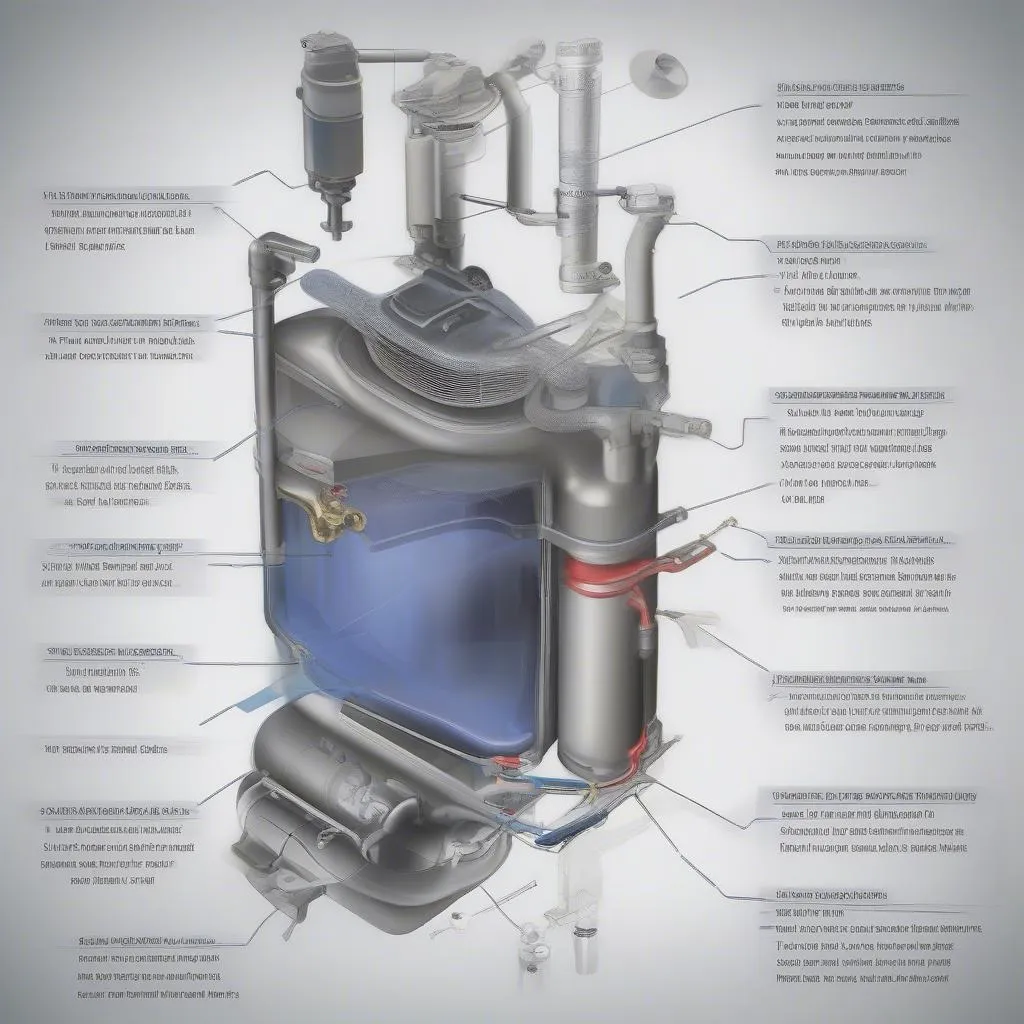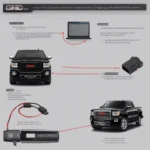The dreaded P1445 OBD2 code is a common issue for Ford owners. This code indicates a very small leak in your vehicle’s Evaporative Emission Control (EVAP) system. While it might seem like a minor problem, ignoring it can lead to more serious issues down the road. This comprehensive guide will cover everything you need to know about the P1445 Ford OBD2 code, from its causes and symptoms to diagnosis and repair options.
Understanding the EVAP System and the P1445 Code
Your Ford’s EVAP system plays a crucial role in reducing harmful emissions. It prevents fuel vapors from escaping into the atmosphere by capturing them in a charcoal canister. When you drive, the engine purges these vapors, burning them during the combustion process. The P1445 code specifically signals that the EVAP system has detected a very small leak, likely a leak rate less than 0.020 inches in diameter.
Common Causes of the P1445 Ford OBD2 Code
Several factors can trigger the P1445 code in your Ford vehicle. Here are some of the most frequent culprits:
- Loose or Damaged Gas Cap: A loose or faulty gas cap is the most common cause of EVAP leaks, including the very small leak indicated by the P1445 code.
- Cracked or Disconnected EVAP Hoses: Over time, the hoses within the EVAP system can become brittle, cracked, or disconnected, leading to leaks.
- Faulty Purge or Vent Solenoid: The purge and vent solenoids control the flow of fuel vapors within the EVAP system. A malfunctioning solenoid can disrupt this process and trigger the code.
- Damaged Charcoal Canister: The charcoal canister absorbs fuel vapors. If it’s damaged or saturated, it may not seal properly, resulting in a leak.
Symptoms of a P1445 Code
In many cases, the P1445 code may not cause any noticeable symptoms beyond the check engine light illuminating on your dashboard. However, you might experience:
- Fuel Smell: A persistent fuel odor, particularly around the vehicle or near the fuel tank, can be a sign of an EVAP leak.
- Decreased Fuel Economy: While a very small leak might not drastically impact fuel efficiency, you might notice a slight decrease in your gas mileage.
Diagnosing the P1445 Code in Your Ford
Accurately diagnosing the source of the leak is key to resolving the P1445 code. Here’s a step-by-step approach:
-
Read the Code: Use an OBD2 scanner to confirm the P1445 code and check for any other stored codes that might provide additional clues.
-
Inspect the Gas Cap: Begin by visually inspecting the gas cap for any cracks, damage, or if it’s not sealing properly. Ensure it’s tightened securely.
-
Visual Inspection of EVAP Components: Visually examine the EVAP hoses, connections, and components for any signs of damage, cracks, loose fittings, or disconnections.
-
Smoke Test: A smoke test is a highly effective method for pinpointing EVAP leaks, even very small ones. This involves injecting smoke into the system to visually identify the leak’s location.
Repairing the P1445 Code
Once you’ve identified the source of the leak, repair options are typically straightforward:
-
Tighten or Replace Gas Cap: If the gas cap is the culprit, simply tighten it securely or replace it with a new one if damaged.
-
Repair or Replace EVAP Hoses: Damaged or leaking hoses will need to be repaired or replaced. Ensure the new hoses are properly secured with clamps.
-
Replace Faulty Solenoids: If testing reveals a faulty purge or vent solenoid, replacing it is necessary to restore proper EVAP system function.
-
Replace Damaged Charcoal Canister: A damaged or saturated charcoal canister cannot be repaired and will require replacement.
Don’t Ignore the P1445 Ford OBD2 Code
While a very small EVAP leak might seem like a minor issue, it’s crucial to address it promptly. Ignoring the P1445 code can lead to:
-
Increased Emissions: Fuel vapors escaping into the atmosphere contribute to air pollution and harm the environment.
-
Failed Emissions Tests: A persistent EVAP leak will likely cause your vehicle to fail emissions tests, preventing registration renewal in many areas.
-
Potential for More Serious Problems: Small leaks can worsen over time, leading to more significant and costly repairs down the road.
Frequently Asked Questions (FAQ)
1. Can I drive my Ford with a P1445 code?
While you can technically still drive with a P1445 code, it’s not recommended to do so for extended periods.
2. How much does it cost to fix the P1445 code?
The repair cost depends on the underlying cause. Simple fixes like a gas cap replacement are inexpensive, while component replacements can be more costly.
3. How do I know if my gas cap is bad?
Inspect it for cracks, damage, or if it’s not sealing properly. If you’re unsure, try replacing it with a new one.
4. Can I fix the P1445 code myself?
Simple repairs like a gas cap or hose replacement are manageable for DIYers. However, more complex issues might require professional assistance.
5. How can I prevent the P1445 code from returning?
Regularly inspect your gas cap and EVAP system components for signs of wear and tear. Addressing issues promptly can help prevent future codes.
Need More Help with Your P1445 Ford OBD2 Code?
We’re here to assist! Contact our team of automotive experts at WhatsApp: +1(641)206-8880 or email us at cardiagtechworkshop@gmail.com. We offer 24/7 support to help you get back on the road safely.


